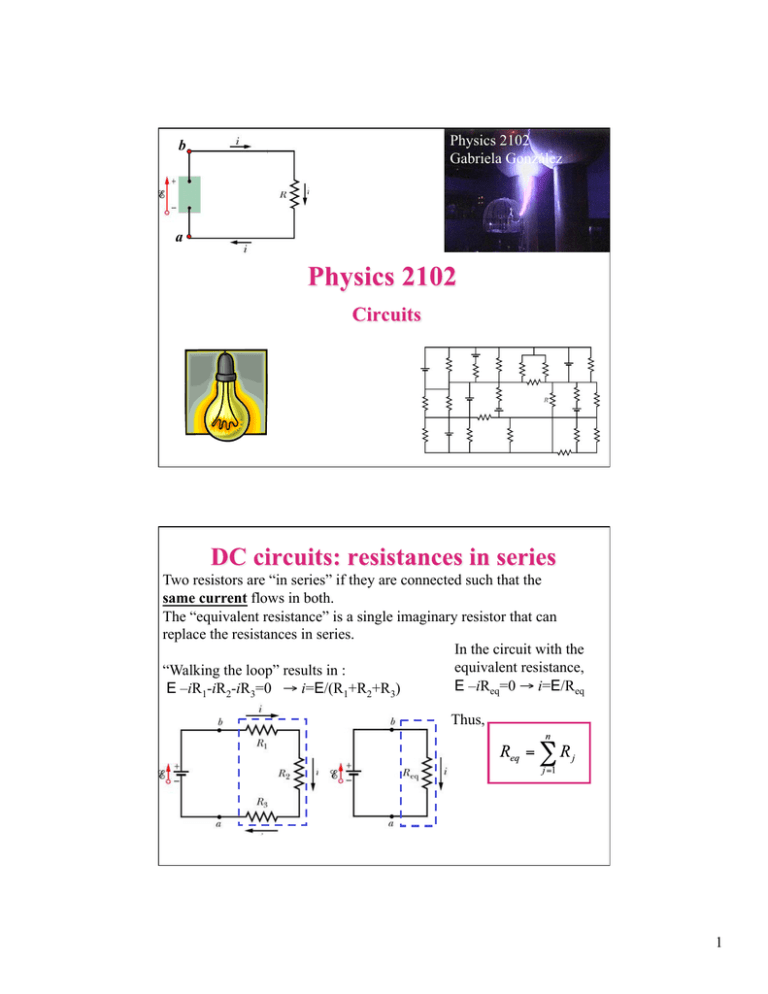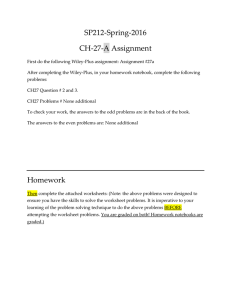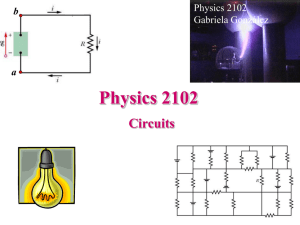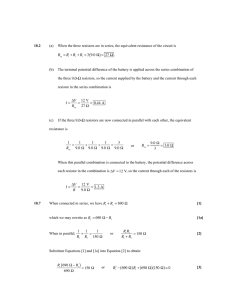1 Physics 2102 Gabriela González b a Two resistors are “in series” if
advertisement

b Physics 2102 Gabriela González a Two resistors are “in series” if they are connected such that the same current flows in both. The “equivalent resistance” is a single imaginary resistor that can replace the resistances in series. In the circuit with the equivalent resistance, “Walking the loop” results in : E –iReq=0 → i=E/Req E –iR1-iR2-iR3=0 → i=E/(R1+R2+R3) Thus, 1 Two resistors are “in parallel” if they are connected such that there is the same potential drop through both. The “equivalent resistance” is a single imaginary resistor that can replace the resistances in parallel. “Walking the loops” results in : E –i1R1=0, E –i2R2=0, E –i3R3=0 The total current delivered by the battery is i = i1+i2+i3 = E/R1+ E/R2+ E/R3. In the circuit with the equivalent resistor, i=E/Req. Thus, Resistors Key formula: V=iR Capacitors Q=CV In series: same current Req=∑Rj same charge 1/Ceq= ∑1/Cj In parallel: same voltage 1/Req= ∑1/Rj same voltage Ceq=∑Cj 2 • Loop rule: when walking along a loop, add potential differences across each element, and make the total equal to zero when you come back to the original point. • Junction rule: at every junction, total current is conserved. • Problem strategy: – Replace resistors in series and in parallel with their equivalent resistors – Draw currents in every wire, and label them – Write the loop rule for each loop (or for the loop that involves your question) – Write the junction rules for the currents. – Solve the equations for the currents. – Answer the question that was asked. Bottom loop: (all else is irrelevant) 12V 8Ω Which resistor gets hotter? 3 a) Which circuit has the largest equivalent resistance? b) Assuming that all resistors are the same, which one dissipates more power? c) Which resistor has the smallest potential difference across it? Assume the batteries are ideal, and have emf E1=12V, E2=9V, and R=3Ω. • Which way will the current flow? • Which battery us doing positive work? • If the potential at A is 0V, what is the potential at B? • How much power is dissipated by the resistor? • How much power is dissipated (or absorbed) by the batteries? 4 Find the equivalent resistance between points (a) F and H and (b) F and G. (Hint: For each pair of points, imagine that a battery is connected across the pair.) • You have two ideal identical batteries, and a resistor. Do you connect the batteries in series or in parallel to get maximum current through R? • Does the answer change if you have non-ideal (but still identical) batteries? 5 • If all batteries are ideal, and all batteries and lightbulbs are identical, in which arrangements will the lightbulbs as bright as the one in circuit X? • Does the answer change if batteries are not ideal? In these circuits, current will change for a while, and then stay constant. We want to solve for current as a function of time i(t). The charge on the capacitor will also be a function of time: q(t). The voltage across the resistor and the capacitor also change with time. To charge the capacitor, close the switch on a. E + VR(t)+VC(t) =0 E - i(t)R - q(t)/C = 0 E - (dq(t)/dt) R - q(t)/C =0 A differential equation for q(t)! The solution is: q(t) = CE(1-e-t/RC) And then i(t) = dq/dt= (E/R) e-t/RC i(t) E/R Time constant=RC 6 +++ --- Assume the switch has been closed on a for a long time: the capacitor will be charged with Q=CE. Then, close the switch on b: charges find their way across the circuit, establishing a current. VR+VC=0 -i(t)R+q(t)/C=0 => (dq/dt)R+q(t)/C=0 + - C Solution: q(t)=q0e-t/RC=CEe-t/RC i(t) = dq/dt = (q0/RC) e-t/RC = (E/R) e-t/RC i(t) E/R The three circuits below are connected to the same ideal battery with emf E. All resistors have resistance R, and all capacitors have capacitance C. • Which capacitor takes the longest in getting charged? • Which capacitor ends up with the largest charge? • What’s the final current delivered by each battery? • What happens when we disconnect the battery? 7 In the figure, E= 1 kV, C = 10 µF, R1 = R2 = R3 = 1 MΩ. With C completely uncharged, switch S is suddenly closed (at t = 0). • What’s the current through each resistor at t=0? • What’s the current through each resistor after a long time? • How long is a long time? 8








